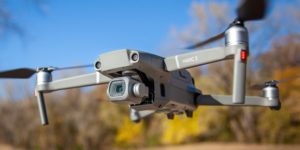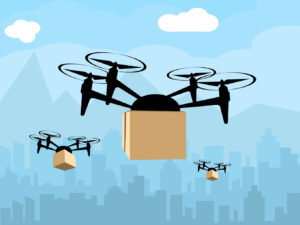This post has been written by Aryan Pujari, a first year student of Amity Law School, Raipur.
Humans are always on the track to achieve anything they desire making technology as an agent. Drones are recent outcome of science which suddenly attended boost in terms of human application for distinctive purposes. Drones are “EYE OF THE SKY”. it is a threat to human health and life which ultimately could be even used as weapon for distance combat. A drone is included with in the group of unmanned aerial vehicles (UAV)and when equipped with arm and ammunition, known as unmanned combat aerial vehicles (UCAV). There has been recent development of rules and regulation so as to control and govern the use of any such vehicle as it carries a threat to cause damage to international humanitarian Law. Cross boarder drone attacks are still in trend .
- Historic Drone Warfare-
Australians used pilot less air balloons those were sent to bomb Vanice leaving it in a fragile condition. The true use of drone came to limelight when in 1990s the US supersonic jets were struggling finding out the Siberian forces in the dense forest of Balkan. They stationed drones which were keeping an eye 24 hours in different regions. These hunter killer drones let the user control it half world away and was broad casting the real time war letting the politician watch the conditions and succouring those in need. Very recently on NOVEMBER 5, 2019 the BSF has recently procured Israeli tethered drones and thermal images to check smuggling and illegal infiltration in Dhubri sector of Assam.
- PROLIFERATION AND MISUSE OF DRONE –
With rising production of drones the general public got multiple choices to serve their own purpose such as detect flaws in construction , for spying also to capture wide angle pictures, at the same the time there’s a lot of cases reported for violation of right to privacy and cross border spying for example- “For example, reports of drone sightings at Gatwick Airport in December 2018 grounded around 1,000 flights for almost 36 hours, affecting more than 140,000 passengers. In 2018 brought new limits where drones can be flown and new registration and education requirements for drone operators and pilots. In January 2020 Government introduced an Air Traffic Management and Unmanned Aircraft Bill to Parliament that included new police powers for enforcing aviation laws (such as the power to issue a fixed penalty notice for certain drone offences)”.[1]
CRIMES USING UAVS
- Corporate Espionage-Corporate espionage is a kind of corporate spying, where a competitor enters into rival’s estate or property without his permission,to access the data or any secrecy so as to serve his own benefit. Drones are good substitute to spies of such notorious parties. Because of its compact size and high accessibility, it helps monitoring everything without leaving a mark behind.
- CYBER ATTACK ON DRONES- WIFI signals is the chain of control of the UAVS or drones which are in use of the general public and could often controlled by a remote station by cloning such signal and that will let that person access all the data captured and stored by the drone. The unknown controller can steal even the real time data .
- TRESPASS OR INVASION-The concept of “no drone zone” emerged out of commission of such crimes. Mostly airports, international borders, Vijay Chowk in Delhi and areas with military installations or any property belonging to another person are no drone zones and breaching these regulation could lead to punishment such as imprisonment.
- DRONE REGULATIONS IN INDIA-
 MINISTRY OF CIVIL AVIATION deals with these affairs . Section 3–Air Transport, Series X, Part I sets limitation on Using a drone. Few of the most important and basic ingredients of the rule contains provision such as –
MINISTRY OF CIVIL AVIATION deals with these affairs . Section 3–Air Transport, Series X, Part I sets limitation on Using a drone. Few of the most important and basic ingredients of the rule contains provision such as –
- All drones except those in the Nano category are issued a Unique Identification Number (UIN).
- permission for commercial drone is required (except for those in the Nano category flown below 50 feet and those in the Micro category flown below 200 feet).
- Drone pilots must maintain a direct visual line of sight at all times while flying.
- 400 feet vertically is the limitation on height .
- No one can use a drone in areas specified as “No Fly Zones”, which include areas near airports, international borders, Vijay Chowk in Delhi, State Secretariat Complex in State Capitals, strategic locations, and military installations.
- One can obtain Permission to fly in controlled airspace by filing a flight plan and obtaining a unique Air Defense Clearance (ADC)/Flight Information Center (FIC) number.”[2]
- Size chart-
Any such Remotely Piloted Aircraft (RPA) Under the weight 250 grams are under nano category, greater than 250 grams and less then 2 kg are under micro, above 2 kg and less then 25 kg falls small, greater than 25 kg and less then or equals to 150kg as medium and greater than 150kg falls under large.[3]
- SECURITY/ SAFETY REQUIREMENTS (CUSTODIAL SAFETY MEASURES)-[4]
The operator of any such RPA will be responsible for the safe custody of the RPA. If operator loses the RPA shall report immediately to the local police office, Bureau of Civil Aviation Security (BCAS) and Director General of Civil Aviation (DGCA) .
- Director of air safety is concerned authority for any kind of drone accident .
- .The owner must report to the Director General of Civil Aviation (DGCA) for cancellation of Unique Identification Number (UIN).
- .The ground control station (while in use or in store) shall be secured from sabotage or unlawful interference.
- The owner can’t sell or dispose such RPAS without the permission or concern of DGCA.
- Any changes in the contact details specified in UIN shall be immediately notified to DGCA and all other concerned agencies.
Sources-
[1]Available at< https://post.parliament.uk/research-briefings/post-pn-0610/>
[2] Available at <uavcoach.com/drone-laws-in-india/>
[3] Categories of RPA, CIVIL AVIATION REQUIREMENTS SECTION 3 – AIR TRANSPORT SERIES X PART I 27TH AUGUST, 2018
[4] SECURITY/ SAFETY REQUIREMENTS, CIVIL AVIATION REQUIREMENTS SECTION 3 – AIR TRANSPORT SERIES X PART I 27TH AUGUST, 2018


